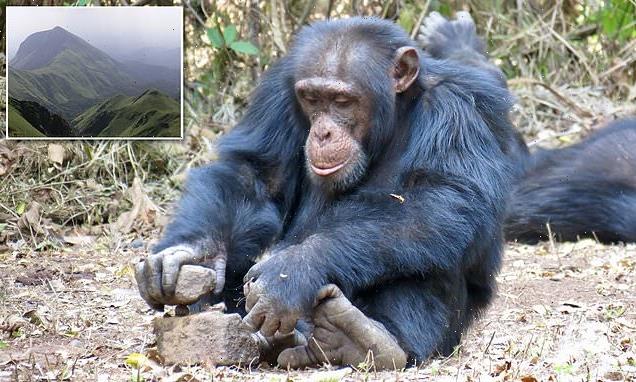
Cracking chimpanzee culture: Apes do NOT automatically know what to do when they come across nuts and stones and must learn the complex behaviour from others, study reveals
- Apes don’t automatically know what to do when they come across nuts or stones
- That is the finding of a new study carried out by University of Zurich researchers
- Experts concluded that chimpanzees must learn complex behaviour from others
- They said it shows that ape culture is more similar to humans than often assumed
Chimpanzees do not automatically know what to do when they come across nuts and stones and must learn the complex behaviour from others, a study has found.
Researchers said their discovery shows that ape culture is more similar to humans than previously thought, whereby skills accumulate over generations and become increasingly efficient or complex.
The study found that a group of wild chimpanzees did not crack nuts when provided with stone tools, even though a separate, nearby community of the apes were using them.
This suggests that the use of tools is not easily picked up by wild chimpanzees, the researchers said, and may hint that this behaviour has to be socially learned.
Chimpanzees do not automatically know what to do when they come across nuts and stones and must learn the complex behaviour from others, a study has found
WHICH ARE SMARTER: CHIMPS OR KIDS?
Most children surpass the intelligence levels of chimpanzees before they reach four years old.
A study conducted by Australian researchers in June 2017 tested children for foresight, which is said to distinguish humans from animals.
The experiment saw researchers drop a grape through the top of a vertical plastic Y-tube.
They then monitored the reactions of a child and chimpanzee in their efforts to grab the grape at the other end, before it hit the floor.
Because there were two possible ways the grape could exit the pipe, researchers looked at the strategies the children and chimpanzees used to predict where the grape would go.
The apes and the two-year-olds only covered a single hole with their hands when tested.
But by four years of age, the children had developed to a level where they knew how to forecast the outcome.
They covered the holes with both hands, catching whatever was dropped through every time.
Humans learn to use tools and other skills from watching each other but there is an ongoing debate about whether this type of cumulative culture is unique.
Previous experiments with captive apes have found that they begin to use tools without being taught, but some scientists say the animals observe humans using tools and may learn this behaviour from them.
Professor Kathelijne Koops, of the University of Zurich (UZH), carried out a long-running field experiment in the Nimba Mountains of Guinea to investigate whether wild chimpanzees can invent a complex behaviour such as nut cracking on their own.
She and her colleagues provided a wild chimpanzee community in Seringbara, Guinea, with the exact tools that some nearby chimpanzee communities use to crack nuts.
The researchers also provided the chimpanzees with nuts, and filmed the results using camera traps.
They observed that the chimpanzees were interested in the tools at first, but did not use them to crack nuts, and gradually lost interest over several months.
However, a separate chimpanzee community in Bossou, Guinea — only 3.7 miles (6km) — do use tools to crack nuts.
The authors suggest that chimpanzee culture, much like human culture, may have developed through learning from those within their social groups.
‘Our findings suggest that chimpanzees acquire cultural behaviours more like humans and do not simply invent a complex tool use behaviour like nut cracking on their own,’ said Professor Koops.
She said the presence of a model from whom to learn appeared to be the missing piece.
‘Our findings on wild chimpanzees, our closest living relatives, help to shed light on what it is (and isn’t!) that makes human culture unique.
‘Specifically, they suggest greater continuity between chimpanzee and human cultural evolution than is normally assumed and that the human capacity for cumulative culture may have a shared evolutionary origin with chimpanzees.’
A total of 35 chimpanzee parties visited the experiments, of which 11 closely investigated the experimental items.
The apes were more likely to explore the experiments when visiting in bigger parties, the researchers found.
Despite demonstrating curiosity and experimentation, the Nimba group failed to figure out how to crack open the nuts, suggesting that chimps need to be taught how to use tools by their peers.
Researchers said their experiment shows that chimpanzees have ‘cumulative culture’, reliant on complex social-learning behaviours that were previously considered an exclusively human trait.
The study was published in the journal Nature Human Behaviour.
WATCH CHIMP MOTHERS TEACH THEIR YOUNG TO USE TOOLS
For the first time ever, researchers have captured footage of wild chimpanzee mothers teaching their offspring to use tools.
The videos taken at the Nouabalé-Ndoki National Park in the Republic of Congo shed new light on the evolution of teaching, showing how young chimpanzees learn from their mothers to catch termites with ‘fishing probes.’
The footage also revealed that the mothers used different strategies to provide their young with tools.
Sometimes, they would bring multiple ‘fishing probes’ to the termite nest to share with their offspring.
Other times, the mothers would divide their own tools in half.
This suggests the mothers were able to anticipate the needs of their young, and come up with different ways to meet these needs with minimal effort.
Source: Read Full Article
